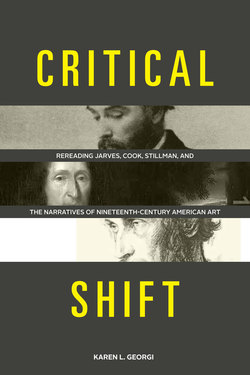Critical Shift

Реклама. ООО «ЛитРес», ИНН: 7719571260.
Оглавление
Karen L. Georgi. Critical Shift
LIST OF ILLUSTRATIONS
Отрывок из книги
CRITICAL SHIFT
and the Narratives of
.....
In short, Jarves’s reputation is derived from both his collection and his writing. The chapter will suggest that the art theory expounded in his texts was fundamentally related to Jarves’s financial and critical goals for his collection, yet the focus of the chapter is the definitions for art and the aesthetic positions that Jarves enunciated and for which he is frequently cited. In other words, I am concerned with interpreting Jarves’s meaning by way of his texts. So the characteristics of the man or the motivations that drove him, which may surface, will arise from his style and from the relationship between his stated priorities and the actual structure of his rhetorical forms.
Concentrating on Jarves’s best-selling and most frequently cited book, The Art-Idea, published in 1864, the chapter proposes to identify and analyze the methodological principles Jarves employed and the primary rhetorical structures that shape his theory. Important among the latter are our poles of the real and ideal. Yet Jarves’s method is also intentionally historicist; he sought to create an objective classificatory scheme based on the idea that art should be understood in its “historical relations.” Thus, while he repeatedly classified art under the categories of the real and ideal, he sought to bind his categories to ostensible historical conditions. He thereby constructed a rationale that validated his aesthetic preferences—as if they carried the status of factual knowledge, like a science of sorts. The real and ideal—or Jarves’s preferred equivalents, the material and spiritual—become terms of evaluation that are represented as objective classifications. With this system, the relative worth of realist versus idealist art was identifiable or even quantifiable not only because it was bound to ostensibly factual cultural characteristics (as opposed to aesthetic opinion), but because it could also be affirmed by historical example.
.....